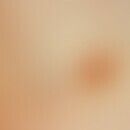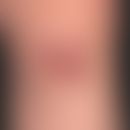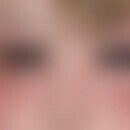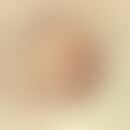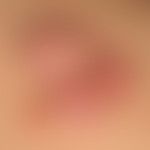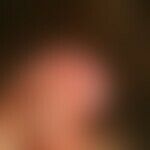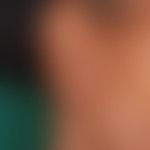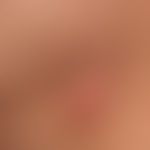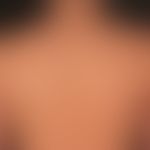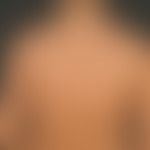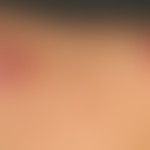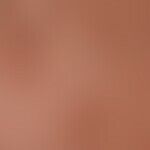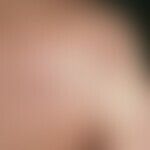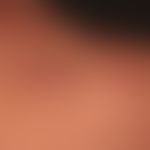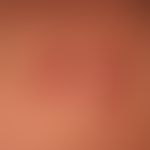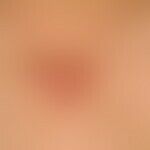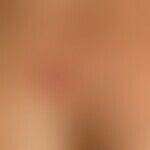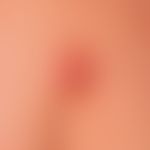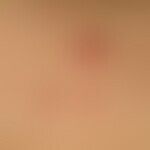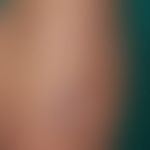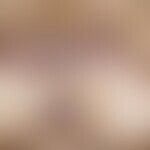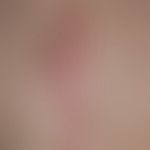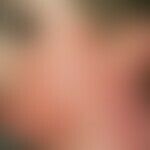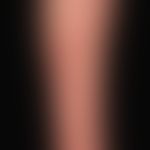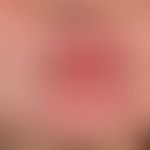Synonym(s)
HistoryThis section has been translated automatically.
DefinitionThis section has been translated automatically.
Benign, circumscribed, often painful or itchy, (inflammatory) connective tissue proliferations affecting a scar field as well as the surrounding healthy skin, which may rarely occur spontaneously (minimal trauma), otherwise months or even a few years after injuries or focal chronic inflammations. The difference to hypertrophic scars is that a keloid by definition exceeds the original scar area, whereas a hypertrophic scar does not. However, smooth transitions are known to occur.
You might also be interested in
ClassificationThis section has been translated automatically.
See also under Scar - classification of scars according to Mustoe
Occurrence/EpidemiologyThis section has been translated automatically.
Young people, blacks and Asians are particularly predisposed (keloid prevalence: 4.5-16%). The risk of contracting keloid is 15-20 times higher in dark-skinned ethnic groups than in Caucasians.
EtiopathogenesisThis section has been translated automatically.
The exact pathomechanism is unknown.
An increase in collagen synthesis by a factor of 20 has been demonstrated in keloids. Structural proteins such as fibrin, fibronectin, glycosaminoglycans and type III collagen are replaced by extracellular matrix proteins, mainly type I collagen. It is unclear whether keloids are the result of increased collagen synthesis or reduced degradation.
The activity of fibroblasts (keratinocytes) and inflammatory cells is increased in keloids. Fibroblasts overexpress the IGF-I receptor (insulin-like growth factor-I receptor) and produce more potent cytokines such as TGF-beta (transforming growth factor), PDGF (platelet derived growth factor) and CTGF (connective tissue growth factor). Keratinocytes release increased amounts of TGF-beta.
The expression of Runx2 in keloid tissue and human keloid fibroblasts is upregulated compared to normal skin tissue and normal human fibroblasts. After transfection with si-Runx2, the proliferation and migration abilities of keloid fibroblasts can be significantly reduced and the apoptosis rate increases (Lv W et al. 2021).
The plasminogen activator inhibitor I (PAI-I) encoded by the SERPINE1 gene and HIF-I-alpha (hypoxia inducible factor I alpha) are both increased in keloid fibroblasts.
Inhibitors of collagen synthesis such as interferons, interleukin-1 and TNF-α represent starting points for new therapeutic strategies.
The occurrence of itching (or pain) can be explained by the sprouting of regenerating, hypersensitive nerves. Inflammatory mediators and an increased content of NGF intensify this.
Genetics (determining genetic factors): Preference for certain ethnic groups - especially people of color with Fitzpatrick skin types IV-VI, familial clustering, occurrence in connection with various syndromes. Syndromes. These include:
- Rubinstein-Taybi syndrome (mutation in the CREBB gene)
- Dubowitz syndrome (named in 1965 after the pediatric neurologist Victor Dubowitz (* 1931) from Sheffield), OMIM: 223370 (polygenetic syndrome including mutations in the HDAC8 gene which codes for histone deacetylase 8.
- Noonan syndrome (polygenetic syndrome in which mutations in the SOS1, BRAF, KRAS, RAF1 and PTPN11 genes have been detected)
- Goeminne syndrome (Zuffardi and Fraccaro (1982) mapped the locus for this syndrome to Xq28)
- Bethlem myopathy (known mutations in the genes: COL6A1, COL6A2 and COL6A3) (Jfri A et al. 2018)
- Keloid formation in polyfibromatosis (Cinotti E et al. 2013)
- X-linked valvular dysplasia with keloids and arthropathies(FLNA gene mutations/FLNA stands for Filamin-A/AtwalPS et al. 2016)
ManifestationThis section has been translated automatically.
Predominantly occurring in young adults. Increasingly rare in older age. The average age of first manifestation is 23 years in both sexes (11-30 years/Shaheen A et al. 2016). There is no sex predominance.
LocalizationThis section has been translated automatically.
Except palms and soles of feet everywhere, especially upper half of the body, pre-sternal, shoulder region, upper arms, earlobes (earrings).
ClinicThis section has been translated automatically.
Weeks to months after an injury or spontaneously occurring. Development of a sharply contrasting, plate- or nodular growth of varying thickness, which protrudes above the surrounding area and, due to rapid growth, exceeds the actual scar area and often shows cancer-scissor-like runners at the edges.
Loss of skin relief, hair and sebaceous glands in the affected area. The colour is initially reddish to brown-red, later white-reddish to ivory. More often, telangiectasia occurs on the surface of the skin lesions.
Not infrequently, there is marked pressure or spontaneous pain, but local itching, paresthesia, numbness, contractures (in the case of localization beyond the joint) may also be present. Keloids are very often perceived as a cosmetic impairment by those affected.
HistologyThis section has been translated automatically.
Image of a cell-rich fibroma. Unchanged or moderately diluted, more rarely acanthotic epidermis. The regular arrangement of the collagen as in normal scars is abolished. Fresh keloids show numerous fibroblasts, increased myxoidal basic substance, collagenous fibres as well as capillaries and inflammatory infiltrates. Later, cell-poor, dense knots of homogenized fibers. Atrophic hair, sebaceous and sweat glands. Disordered alignment of collagen fibres.
Differential diagnosisThis section has been translated automatically.
Hypertrophic scar: By definition, does not exceed the original scar field! Thus easy to distinguish.
Dermatofibroma (histiocytoma): Usually asymptomatic, coarse, yellow-reddish or reddish-brown nodule that does not or only slightly exceeds the surrounding skin level (important DD), sometimes also centrally sunken, well circumscribed, firmly cemented to the epidermis. Size rarely > 1.0 cm.
Dermatofibrosarcoma protuberans: Up to 10 cm in size, very coarse, skin-colored to brownish-livid (always lacking the bright red color of the keloid), bumpy nodule consisting of a nodular and an underlying squamous portion. Usually not painful. typical is the "iceberg phenomenon". Histology is diagnostic.
Leiomyoma: Usually surface smooth, localized nodules atypical of keloid, barely 0.5cm in size, often appearing in groups.Histology is diagnostic.
Metastasis of a systemic tumor (usually rapid growth; keloid-untypical localization, consistency bulging-firm but not hard).
Lymphoma of the skin (keloid-untypical localization, consistency firm but not hard, histology is diagnostic).
TherapyThis section has been translated automatically.
The treatment of keloids is extremely difficult and protracted: the keloids should be at rest before correction, i.e. they should no longer increase in size. In addition, therapy should only be performed with very strict indications (see also prophylaxis).
- Glucocorticosteroids (evidence level III): Therapy of 1st choice is multiple, strictly intralesional application of glucocorticoids, e.g. triamcinolone acetonide and local anesthetics (1 ml Volon A 10 (40) + 1-2 ml 1% scandicaine). Note: Take your time when injecting, use a thin needle and overcome the internal pressure of the keloid only with a small amount of force (at this moment a so-called "blanching effect" occurs, which indicates the sufficient amount of therapy). Application (depending on size and success) e.g. 1 time/month for 6-12 months. Regression rates between 50-100%; recurrence rates between 9-50%. Sublesional application is easier but futile. Caveat. Risk of adipose tissue atrophy, especially in women!
- Occlusive therapy (evidence level III); complementary therapy: Permanent occlusion and hydration of the stratum corneum with silicone gel sheet (e.g. Mepiform, Cicacare, Dermatix) or polyurethane plaster (Hansaplast scar reduction plaster) leads to remarkably good results when applied consistently and permanently (> 3 months).
- Compression therapy (evidence level III); complementary therapy: For larger keloids, depending on age, size and localization, a different approach is taken: If topographically possible, consistent wearing of a pressure pad over several months. The continuous permanent pressure and the external oxygen reduction reduce fibroblast growth. If performed consistently at an early stage, often excellent efficacy. Elastic bandages, pads, and specially made compression garments make this procedure easy to perform on joints and thorax, but technically more difficult on sites such as the face and neck. This therapy must be performed for at least 1 year.
- Alternative: Cryosurgery: 2 times cycle, temperature in the keloid center -30 °C. Immediately after thawing, injection of 40-80 mg triamcinolone acetonide into the edematous keloid area. Repeat method if necessary. Possibly in combination with pressure pad and silicone gel sheet.
- Alternative: Laser therapy: Laser systems for vaporization and ablation. Keloids can be ablated e.g. with CO 2 laser down to the skin level. After ablation of the exophytic parts, further treatment with cryocontact therapy or by means of intralesional glucocorticoid injections. Alternatively, pulsed dye lasers (585-595nm) are recommended.
- Alternative: UV therapy: Recent observations also support UVA irradiation after surgical planing/excision at 20 J/cm2, 4 times/week for 4-6 weeks.
- Alternative: Intralesional, 5-fluorouracil treatments(1 time/week; concentration of injectate: 50 mg/ml. Total dose per injection treatment 50-150 mg), max 16 injections (NW: Injections are painful; ulceration in rare cases. Note: This monotherapeutic approach is not recommended by experts!. Guidelines recommend monthly intralesional therapy of a combination of 5-fluorouracil with triamcinolone acetonide in a mixing ratio of 9:1 (0.9ml 50mg/ml 5-fluorouracil: 0.1ml 40mg/ml triamcinolone acetonide). In versch. In various studies, good results were achieved with a mixing ratio of 1:3 (5-fluorouracil/trimacinolone acetonide).
- Alternatively (third line therapy): Surgical partial resection and generous intralesional application of 40-80 mg triamcinolone acetonide immediately after surgery. Use only for keloids with concomitant movement restriction, in case of non-response to other therapies, in case of very large and cosmetically significantly disturbing keloids! The risk of recurrence should not be underestimated (50-100% in monotherapeutic surgical procedures!) with possibly more aggressive growth behavior than before and enlargement of the original keloid.
- Alternative (experimental): Avotermin (TGF-beta3), a potent antifibrinolytic cytokine applied to fresh incisional wounds (placebo-controlled studies are available).
- Alternative (experimental): Treatment of extensive keloids by tattooing ("pricking with a prick needle") a bleomycin solution (concentration 1.5 IU/ml and 40 pricks/mm2) is a good alternative therapy.
- Alternative therapy, topical: (level of evidence III): Onion extracts, heparin, or allantoin should inhibit excessive fibroblast proliferation. In the therapy-free interval, massage the keloid several times with a scar therapeutic agent (e.g. Contractubex) for several minutes, but the success is usually rather moderate.
- Alternatively, as ultima ratio and absolute therapy resistance: combination therapy of local corticosteroid injection immediately following surgery, compression or soft X-ray irradiation (ED: 3 Gy at weekly intervals, GD: 12 Gy).
- Concluding general remarks:
- In many cases, because of the complexity of the pathogenesis and the unpredictable response of the treatment to be chosen, a combination of several therapeutic procedures is recommended, such as compression and/or silicone gel sheeting and/or (in the absence of success) surgical procedure, possibly with internal mass reduction and immediately following cryosurgery or compression and/or repeated cryosurgery.
- The procedure to be used also depends on the particular localization, growth behavior, size of the keloid and the experience of the therapist (e.g., there is no alternative for compression therapy in keloid of the earlobe).
- In addition to evidence, the personal experience of the therapist, who knows how to safely handle the therapeutic agents to be used, is of decisive importance!
ProphylaxisThis section has been translated automatically.
Prevention! Consider the risks of keloid formation before every operation! Avoidance of elective surgery in predisposed patients (own and family history) at a young age, as well as in predisposed areas such as the décolleté, shoulder and back region.
If surgery cannot be avoided, care should be taken to ensure tension-free sutures when closing the wound.
Patch application for 12 weeks can significantly reduce the risk of keloid.
In addition, silicone gels or plasters (see above) can be applied after epithelialization.
LiteratureThis section has been translated automatically.
- Alibert JLM (1816) Quelques recherches sur les cheloides. Mem Soc Médicale d`Émulation 8: 744
- Alibert JLM (1816) Note sur la chéloïde. Journal universel des sciences médicales (Paris) 2: 207-216
- Apikian M et al. (2004) Intralesional 5-fluorouracil in the treatment of keloid scars. Australas J Dermatol 45: 140-143
- Aschoff R (2014) Therapy of hypertrophic scars and keloids. Dermatologist 65: 1067-1077
- Atkinson JA et al. (2005) Randomized controlled trial to determine the efficacy of paper tape in preventing hypertrophic scar formation in surgical incisions that transverse Langer`s skin tension lines. Plast Reconstr Surg 33: 1291-1303
Atwal PS et al. (2016) Novel X-linked syndrome of cardiac valvulopathy, keloid scarring, and reduced joint mobility due to filamin A substitution G1576R. Am J Med Genet A 170A:891-895.
- Breasted JH (1930) The Edwin Smith surgical papyrus,Vol 1. hieroglyphic translation and commentary.University of Chicago Press, Chicago, pp. 403-406
- Cinotti E et al. (2013) Arthropathy, osteolysis, keloids, relapsing conjunctival pannus and gingival overgrowth: a variant of polyfibromatosis? Am J Med Genet A 161A:1214-1220.
- Gira AK et al. (2004) Keloids demonstrate high-level epidermal expression of vascular endothelial growth factor. J Am Acad Dermatol 50: 850-853
- Jfri A et al. (2018) Spontaneous Keloids: A Literature Review. Dermatology 234:127-130.
- Kelly AP (2004) Medical and surgical therapies for keloids. Dermatol Ther 17: 212-218
Lv W et al. (2021) Treatment of keloids through Runx2 siRNA-induced inhibition of the PI3K/AKT signaling pathway. Mol Med Rep 23:55.
- Marneros AG et al (2001) Clinical genetics of familial keloids. Arch Dermatol 137:1429-1434.
- Mustoe TA et al. (2005) International clinical recommendations on scar management. Plast Reconstr Surg 110: 560-571
- Poetschke J et al. (2016) Current options for the treatment of pathological scarring. J Dtsch Dermatol Ges 14:467-477.
Shaheen A et al. (2016) Risk factors of keloids in Syrians. BMC Dermatol 16:13.
- Van Loey NE et al. (2008) Itching following burns: epidemiology and predictors. Br J Dermatol 158:95-100.
- van de Kar AL et al. (2014) Keloids in Rubinstein-Taybi syndrome: a clinical study. Br J Dermatol 171:615-621.
Incoming links (35)
Acne conglobata; Argon laser; Bead pit; Borrelia lymphocytoma; Chemical burn; Dermatomyofibroma; Dubowitz syndrome; Dye laser; Elastofibroma; Elastosis perforans serpiginosa; ... Show allOutgoing links (38)
BRAF Gene; Co2 laser; Col6a1-3 Genes; Cryosurgery; Cytokines; Dermatofibroma; Dermatofibrosarcoma protuberans (overview); Dubowitz syndrome; Fibroma; FLNA Gene; ... Show allDisclaimer
Please ask your physician for a reliable diagnosis. This website is only meant as a reference.
